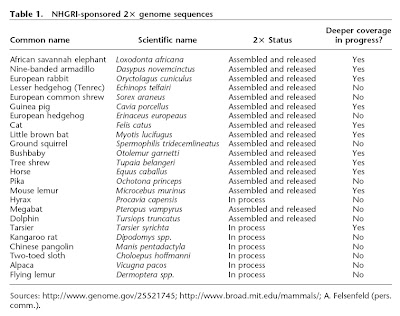In the trade-off between breadth vs. depth -- or phylogenetic diversity vs. individual resolution -- this leans more towards the former. Of course, this does not preclude improving coverage later, and in fact many of the 2x genomes are already being sequenced to a higher redundancy.
Of the greatest interest to me, about 32% of the available cat sequence is made up of transposable elements, mostly LINEs and SINEs as in other mammals. The percentage might be higher overall since much of the non-coding portion of the genome was not sequenced in the cat. Not having this information is one of the downsides of low coverage. On the other hand, the TE content looks to be very similar to dog anyway, so this is useful information that would not be available yet if we had to insist on 7x coverage for every species.
Speaking of the dog genome, it bears noting that a survey sequence of only about 25% of the genome at 1.5x coverage was released in 2003 (Kirkness et al. 2003). This initial sequence (from Craig Venter's poodle Shadow) was followed by work from a different set of authors who released a complete dog genome (7.5x coverage) in 2005 (Lindblad-Toh et al. 2005). So again, releasing a partial sequence certainly does not stop a more detailed coverage from being done down the line.
In an ideal world we might have high redundancy, totally complete (not just euchromatic), fully annotated, completely accurate genome sequences from multiple individuals from thousands of species -- but that isn't reality for the time being.
Given such constraints, do you think we should have incomplete data from lots of species, or high depth information from a few species? In other words, are you a cat genome person or a dog genome person?
http://www.genome.gov/Images/feature_images/domesticcat_image.jpg
http://www.genome.gov/Images/feature_images/dog_image.jpg
http://www.genome.gov/Images/feature_images/dog_image.jpg
_________
ps: You'll note that I resisted the temptation to post pictures of my own cats -- you're welcome.








Comments